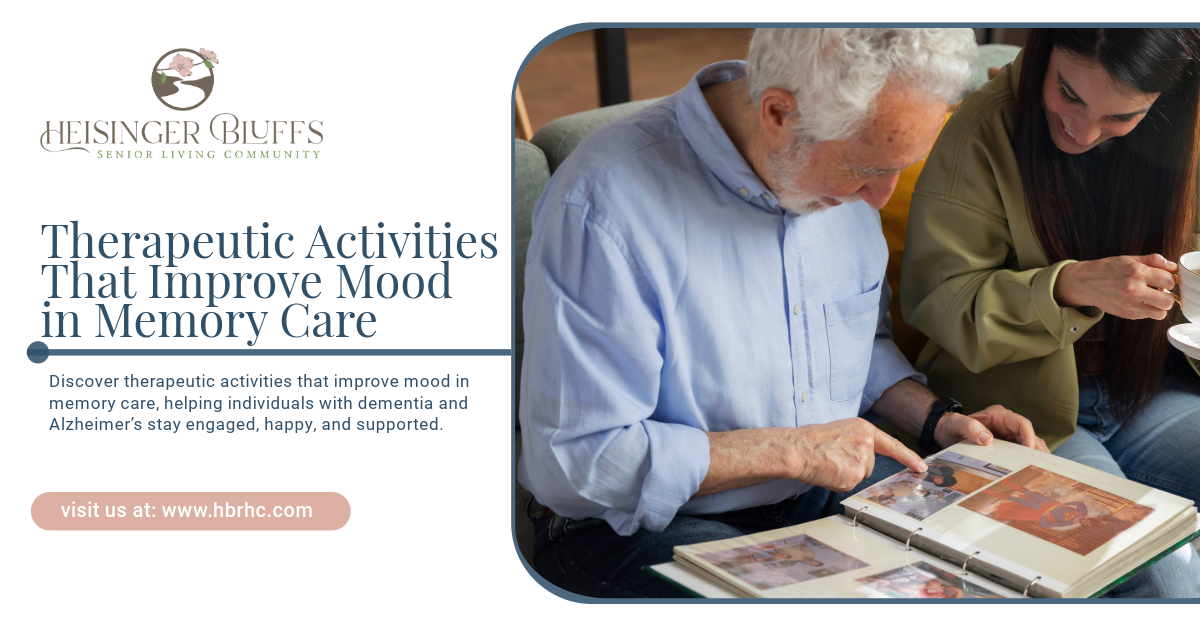Therapeutic Activities That Improve Mood in Memory Care

Caring for someone with memory loss, whether due to Alzheimer's disease, dementia, or another condition, can be both challenging and rewarding. One of the most critical aspects of providing effective care in memory care communities is helping residents maintain a positive mood, engagement, and overall well-being. Therapeutic activities are designed not only to stimulate cognitive function but also to improve emotional health and mood, making them an essential component of memory care.
Memory care is more than just offering a safe environment for individuals with memory loss; it is about enriching their lives with meaningful activities that promote happiness, social interaction, and a sense of purpose. In this blog post, we will explore a variety of therapeutic activities that improve mood in memory care, highlighting their benefits and providing practical ideas for caregivers and family members to incorporate them into daily routines.
Why Therapeutic Activities Are Essential in Memory Care
Memory loss can lead to frustration, confusion, anxiety, and depression, which can all affect an individual’s overall mood and quality of life. Therapeutic activities aim to engage individuals with memory loss in ways that help them retain cognitive abilities, encourage social interaction, and promote physical activity—all of which contribute to an improved emotional state.
These activities are designed to do more than simply occupy time. They stimulate the brain, promote positive feelings, reduce anxiety, and help individuals feel more connected to their environment. The right therapeutic activities can also help individuals with memory loss feel more in control, boosting self-esteem and improving their overall mood.
Some key benefits of therapeutic activities in memory care include:
- Improved cognitive function: Stimulating the brain through games, puzzles, and mental challenges can help keep the mind sharp.
- Enhanced emotional well-being: Activities that promote socialization, creativity, and physical engagement help reduce feelings of isolation and depression.
- Increased physical activity: Exercise and movement-based activities help improve physical health, reduce restlessness, and promote better sleep.
- Better social connections: Group activities allow individuals with memory loss to interact with others, reducing feelings of loneliness and isolation.
- A sense of accomplishment: Successfully completing activities provides a sense of achievement, which can significantly boost mood and confidence.
Therapeutic Activities That Improve Mood in Memory Care
1. Art Therapy
Art therapy is one of the most effective ways to improve mood and stimulate cognitive function. The creative process allows individuals to express their emotions without relying on words, which can be difficult for those with memory loss. Art activities like painting, drawing, or crafting also promote fine motor skills and can be a relaxing and meditative experience.
Benefits of Art Therapy in Memory Care:
- Provides a creative outlet for self-expression.
- Encourages mindfulness and relaxation, reducing anxiety.
- Improves fine motor skills and coordination.
- Helps individuals reconnect with their emotions, which can be therapeutic.
- Fosters a sense of accomplishment and pride.
Examples of Art Therapy Activities:
- Painting or coloring
- Clay modeling or sculpting
- Crafting with beads or fabric
- Collage making using magazines or photographs
- Drawing or doodling with markers or crayons
2. Music Therapy
Music has a unique ability to impact mood and emotions. For individuals with memory loss, familiar songs or types of music can evoke positive memories, reduce agitation, and promote relaxation. Music therapy can involve both active participation (singing, playing instruments) and passive listening. Music has been shown to activate different areas of the brain, making it an incredibly valuable tool for individuals with dementia or Alzheimer’s disease.
Benefits of Music Therapy in Memory Care:
- Stimulates memory recall, especially when listening to familiar tunes.
- Reduces feelings of agitation or anxiety.
- Promotes relaxation and calmness.
- Encourages social interaction when done in groups.
- Improves motor coordination if involved in rhythmic activities.
Examples of Music Therapy Activities:
- Listening to familiar music or songs from the past.
- Group sing-alongs or karaoke sessions.
- Playing simple instruments, such as tambourines or maracas.
- Rhythmic clapping or tapping to the beat.
- Musical storytelling or dance.
3. Pet Therapy
Interacting with animals has long been recognized as a way to improve mood and provide comfort to people in various healthcare settings, including memory care. Pet therapy can help individuals with memory loss feel less anxious and more connected to the present moment. Whether it’s spending time with a therapy dog, watching birds, or petting small animals, these interactions can provide emotional support, increase feelings of joy, and even improve physical health.
Benefits of Pet Therapy in Memory Care:
- Reduces feelings of loneliness and isolation.
- Increases levels of oxytocin, a hormone linked to emotional bonding and happiness.
- Helps lower blood pressure and reduce stress.
- Promotes social interaction and communication.
- Encourages physical activity through pet care routines.
Examples of Pet Therapy Activities:
- Petting or playing with therapy dogs or cats.
- Watching or feeding birds or fish.
- Caring for small pets, such as rabbits or guinea pigs.
- Going for short walks with a therapy animal.
- Playing with animal-themed toys or puzzles.
4. Exercise and Movement-Based Activities
Physical activity is crucial for improving mood, and even small movements can have a positive effect on emotional well-being. Exercise releases endorphins, which are natural mood boosters. Movement-based activities can also improve physical health, which in turn promotes a sense of accomplishment and confidence. For individuals with memory loss, gentle exercises like chair yoga, walking, and stretching can improve flexibility, strength, and mobility while also reducing feelings of frustration and anxiety.
Benefits of Exercise in Memory Care:
- Boosts mood through the release of endorphins.
- Improves physical health and mobility, contributing to greater independence.
- Reduces symptoms of anxiety and depression.
- Increases social interaction when done in group settings.
- Improves sleep quality and reduces restlessness.
Examples of Exercise and Movement-Based Activities:
- Chair yoga or stretching exercises.
- Short walks around the community.
- Group dance sessions or movement to music.
- Gentle aerobics or water aerobics.
- Balloon volleyball or simple games involving light movement.
5. Reminiscence Therapy
Reminiscence therapy involves engaging individuals with memory loss in conversations and activities that encourage recalling past experiences. This type of therapy can be particularly beneficial for individuals with dementia, as it taps into long-term memory, which is often less affected than short-term memory. Reminiscence therapy helps individuals feel connected to their past, reduces feelings of confusion, and improves mood by allowing them to relive positive memories.
Benefits of Reminiscence Therapy:
- Stimulates memory and cognitive function.
- Promotes socialization and interaction with others.
- Encourages feelings of nostalgia and comfort.
- Helps reduce anxiety and agitation by providing a sense of stability.
- Strengthens family connections when used during visits.
Examples of Reminiscence Therapy Activities:
- Looking through photo albums or scrapbooks.
- Listening to stories from the past or life history discussions.
- Watching movies or TV shows from the past.
- Recreating familiar smells, foods, or objects from earlier life experiences.
- Engaging in activities that were once part of the person’s daily routine (e.g., knitting, baking, gardening).
6. Gardening Therapy
Gardening is another highly beneficial therapeutic activity for memory care residents. Not only does it provide a peaceful and calming environment, but it also allows individuals to connect with nature and experience a sense of accomplishment as they plant and nurture living things. Gardening can be done individually or as part of a group activity and is particularly beneficial for residents with Alzheimer’s or dementia.
Benefits of Gardening Therapy in Memory Care:
- Reduces stress and promotes relaxation.
- Provides a sensory experience, which can be very grounding.
- Encourages physical activity, such as digging, planting, and watering.
- Boosts mood through the satisfaction of growing plants.
- Promotes cognitive stimulation through the care and observation of plants.
Examples of Gardening Therapy Activities:
- Planting flowers, vegetables, or herbs.
- Watering plants or caring for an indoor garden.
- Arranging flowers for decorative purposes.
- Organizing pots, planters, or garden spaces.
- Seasonal gardening tasks, such as harvesting or pruning.
Final Thoughts
Therapeutic activities play a vital role in enhancing the mood and well-being of individuals in memory care communities. By incorporating activities like art therapy, music therapy, pet therapy, exercise, reminiscence therapy, and gardening into daily routines, memory care providers can significantly improve emotional health, reduce anxiety, and help residents feel more connected to their environment and others around them.
At Heisinger Bluffs, we understand the importance of creating a supportive and engaging environment for residents with memory loss. Our team is committed to providing therapeutic activities that promote emotional well-being, foster a sense of accomplishment, and improve the overall quality of life for each resident.
Frequently Asked Questions
What are some simple therapeutic activities for memory care residents?
Simple therapeutic activities can include listening to music, doing light stretches or chair yoga, participating in reminiscence therapy, and spending time with therapy pets. These activities provide emotional support and help keep residents engaged.
How does art therapy benefit individuals with memory loss?
Art therapy provides a creative outlet for self-expression and helps individuals with memory loss process their emotions. It can improve fine motor skills, reduce anxiety, and foster a sense of accomplishment.
What are the benefits of pet therapy for memory care residents?
Pet therapy helps reduce loneliness and anxiety, improves mood, and encourages physical activity. Interacting with animals also stimulates emotional bonds, providing comfort and joy for residents with memory loss.
Sources:
- https://www.alzheimers.org.uk/get-support/help-dementia-care/understanding-supporting-person-dementia-psychological-emotional-impact
- https://www.webmd.com/alzheimers/brain-stimulation-alzheimers
- https://www.mayoclinic.org/diseases-conditions/alzheimers-disease/symptoms-causes/syc-20350447
- https://www.health.harvard.edu/staying-healthy/exercising-to-relax











